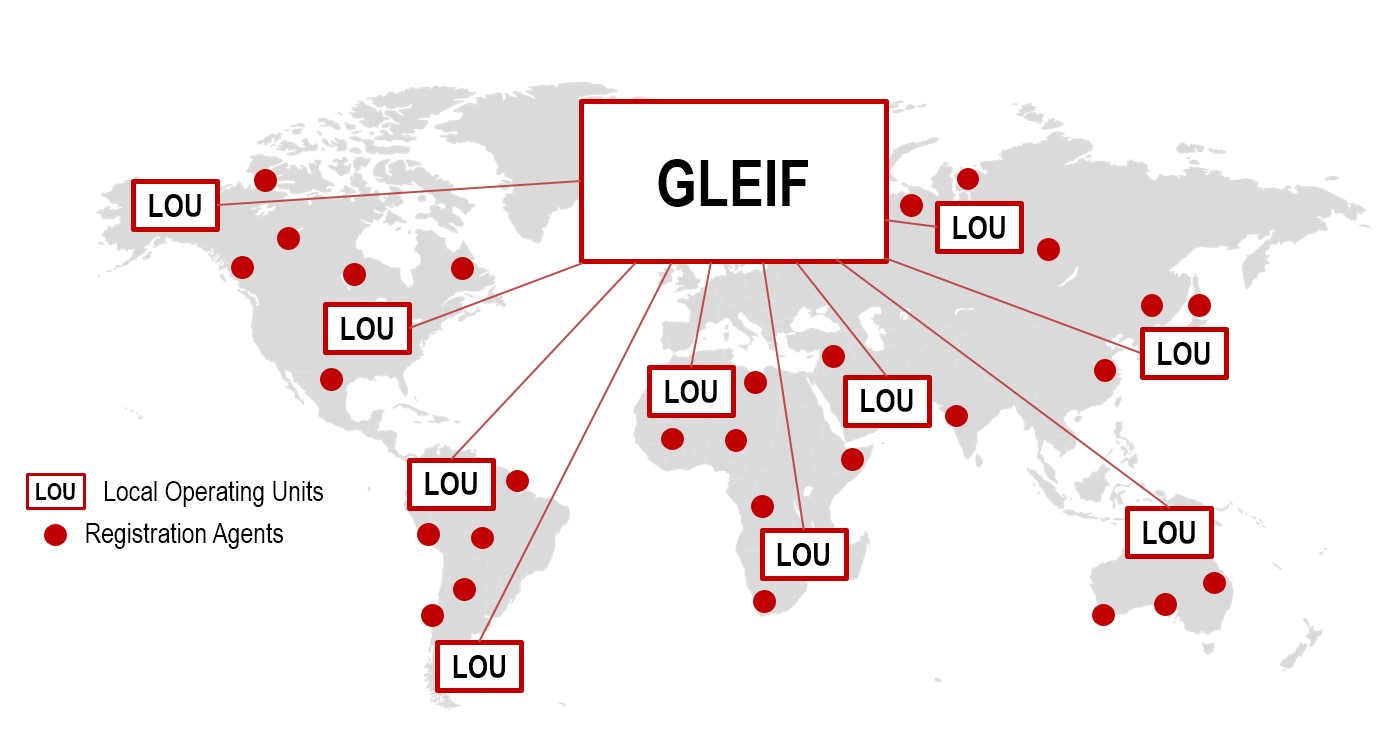The organizational structure of the LEI system is constructed of three major tiers:
- LEI ROC – LEI Regulatory Oversight Committee
- GLEIF – Global Legal Entity Identifier Foundation
- LOUs – Local Operating Units
Recently, GLEIF added a forth element to the LEI system’s organizational structure – Registration Agents, that cooperate with selected LOUs and provide additional resources for the registration of legal entities.
The organizational structure of the LEI system is presented in the following diagram:

LEI ROC – LEI Regulatory Oversight Committee
The Legal Entity Identifier Regulatory Oversight Committee was created in 2012 as a stand-alone organization based on the 2011 recommendations by the FSB (Financial Stability Board), further endorsed by the G20 group of nations, as expressed in the ROC Charter.
Formally, LEI ROC is a group formed of 90 public authorities from more than 50 countries. The group has 71 participants enjoying the status of full members and 19 participants with observer statuses. The full list of members and observers is published on the LEI ROC website [1].
[1] https://www.leiroc.org/about/membersandobservers/index.htm.
In a nutshell, LEI ROC represents the public financial market authorities from many countries and jurisdictions across the world. The fundamental elements of its strategy are geared towards supporting the growth of the LEI system by increasing the number of regulations that require LEI for identification purposes, spreading its use over new jurisdictions and facilitating voluntary adoption by independent market participants.
GLEIF – Global Legal Entity Identifier Foundation
The Global Legal Entity Identifier Foundation, established in 2014 as supra-national, not-for-profit organization acts as the operational arm of the Global LEI system and in its activity is overseen by LEI ROC. The fundamental elements of the GLEIF strategy support the implementation and use of the LEI system, as well as maintaining its operational integrity.
GLEIF is in charge of the management of LEI issuers (LOUs – see below) and the goal of this activity is to ensure that the registration services provided by issuers are trusted, open and reliable worldwide.
The services that GLEIF offers to the global public include:
- Accreditation services for LEI issuers.
For services that include rigorous evaluation processes, this ensures that all LEI issuing organizations meet their requirements, as specified in the Master Agreement between them and GLEIF.
- Providing free access to the global LEI data pool for all users.
GLEIF maintains the global index and search engine for the entire set of LEI records. It also provides the concatenated files (described in LEI Files) that are updated daily from the information made available by LOUs (also available here).
- Data quality management
GLEIF has implemented a data quality program which ensures the integrity of the LEI data pool and monitors the quality of LEI master data records. The program includes a monthly publication of data quality reports. (see: [1])
[1] – https://www.gleif.org/en/lei-data/gleif-data-quality-management/about-the-data-quality-reports
- Ensuring the implementation of open data principles.
GLEIF is an active promoter of the open data principles and formally endorses the Open Data Charter. In practice, it supports LEI system data in conforming to the following principles:
- Open by default.
- Timely and comprehensive.
- Accessible and usable.
- Comparable and interoperable.
- For improved governance and citizen engagement.
- For inclusive development and innovation.
LOUs – Local Operating Units
LOUs – Local Operating Units are LEI issuers – the actual organizations authorized to issue LEIs to legal entities engaging in financial transactions.
LOUs provide registration and renewal services and their fundamental role is to act as the primary interface between legal entities and the global LEI system. It is important to remember that there is no exclusive assignment of a given LOU to the jurisdiction in which it operates. In other words, legal entities that want to obtain their LEI are not limited to using LOUs in their own countries. They can apply for registration at any accredited LOU, which can therefore operate in any given jurisdiction.
The list of LEI issuing organizations is available on the GLEIF website.
As of December 2017, there are 14 fully GLEIF accredited LOUs out of a total of 31 LOUs (the remaining LOUs were “pre-LOUs” accredited by LEI-ROC).
More about the Registration Agents is available on the GLEIF website.
LEI.INFO is the Ubisecure RapidLEI and Bloomberg in partnership with Business Entity Data B.V. – a DTCC company.
Registration Agents
In the fall of 2017, facing a new EU regulatory requirement (MiFiD II/MiFIR) and further seeking to enhance the process of issuing new LEIs, GLEIF introduced the concept of the ‘Registration Agent’.
A Registration Agent helps legal entities to access the network of LEI issuing organizations responsible for performing LEI issuance and other related services. A Registration Agent does not invalidate the role of LOUs as LEI issuers. However, by offering pre-registration services, delivering data in bulk, processing registration fees and offering additional services, Registration Agents help in making the LEI system more responsive and agile.
Every Registration Agent is directly connected to LEI issuing organizations and may decide to partner with one or more of them to help facilitate its role.
Vendor Relationship Group
Another important organization created within the GLEIF system is the GLEIF Vendor Relationship Group.
The Group gathers representative organizations of LEI data and technology vendors, who offer LEI data to their customers in their products and services.
More information about the Group can be found on the GLEIF website.